Calling in the Gilded Age
“Everyone who pretends to know anything about Society with a capital “S” must know all about how, when, and where to leave cards.”
-“Social Amenities for the School Girl,” The San Francisco Call, 21 January 1912, 36.
Social interactions in Gilded Age America were governed by a series of complex and rigid rules, or etiquette. Calling, or visiting, was the social recreation of the upper-class and the calling card was an essential element of the exercise.
Calls were much more than casual visits; the custom helped cement one’s position in society. The rules of calling were precise and strict, but it was essential to navigate the bewildering process with ease lest you commit an unforgivable faux pas: “Calling is so intimately interwove in society’s law, that not to know when to call, how to call and on whom to call, would be an unpardonable breach of etiquette.” Etiquette guidebooks of the period outlined the proper protocol for the practice.
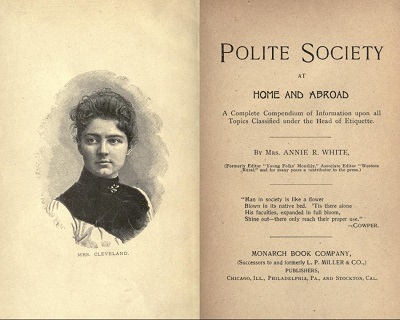
A polite call, or visit, lasted no more than ten to fifteen minutes. If the person called upon was unavailable or not at home, the caller left a personal card, typically on a silver tray left in the entry hall explicitly for that purpose, or with a servant who would deliver it to the lady of the house. The receiver reciprocated with a call or a card if he or she desired to continue the social relationship.
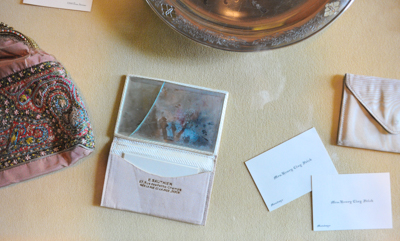
The Frick Pittsburgh’s collection includes a number of calling cards used by the Frick family at the turn of the twentieth century. Traditional cards were on heavy, plain, unlined white or cream paper with an elegant script. “Mondays” is inscribed at the bottom left of Mrs. Frick’s calling card, indicating the day she set aside to receive calls from her friends and acquaintances.
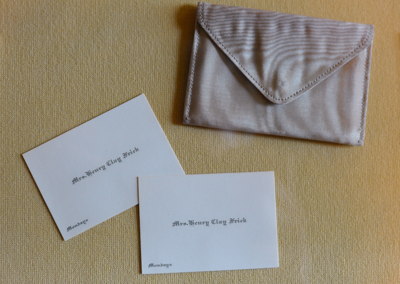
Another card lists Mr. and Mrs. Frick’s names. This would most likely have been used during the first year of their marriage; after that, separate cards were in order.
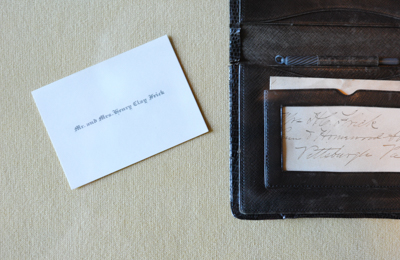
Ladies typically kept their calling cards in cases in their purses or handbags. A beautiful embroidered purse from Parisian retailer E. Gauthier holds a case filled with cards printed “Miss Frick” and Clayton’s address. Individual cards for Mr. Frick and Childs are also represented in the collection as well as a black-bordered mourning card for Mrs. Frick, probably used after the death of her husband in 1919.
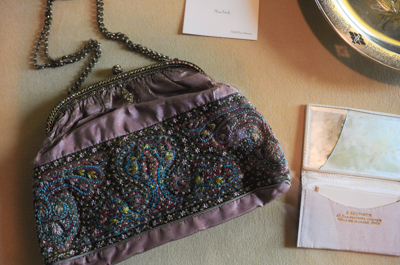
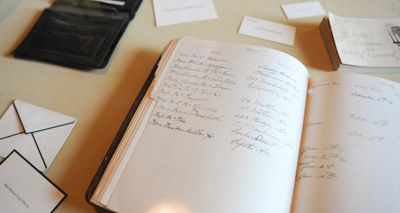
One of the most evocative artifacts in the museum’s archival collection is a visiting list kept by Adelaide Frick between 1896 and 1897. In it she details the names and addresses of those within her social circle, noting the days of visits made and returned. Recognizable names include members of her extended family, neighbors, and the wives of her husband’s business colleagues including Mrs. W.H. Rea, Mrs. B.F Jones, and Mrs. William Thaw.
Also in the collection is Stationery Fashions and Correct Forms for Engraving, a sample book published by New York stationery company E.P. Dutton in 1889. The booklet details the latest fashions for visiting cards, invitations, and letterhead. Inset samples illustrate stylish scripts and type and quality paper as well as the proper language for invitations to various social events including receptions, dinner parties, and balls. The pages are littered with scribbles and drawings, no doubt the hand of one of the Frick children.
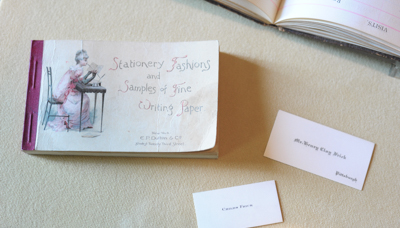
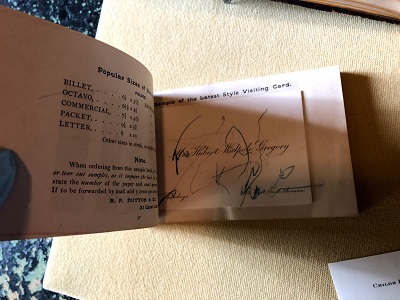
Visitors to Clayton this summer will see these objects and many more on display in the house. If you’re interested in learning more about the social lives of women during the Gilded Age, join us for this summer’s special tour, Duty & Devotion: The Women of Clayton, running through September 30, 2018.
Calls were much more than casual visits; the custom helped cement one’s position in society. The rules of calling were precise and strict, but it was essential to navigate the bewildering process with ease lest you commit an unforgivable faux pas: “Calling is so intimately interwove in society’s law, that not to know when to call, how to call and on whom to call, would be an unpardonable breach of etiquette.” Etiquette guidebooks of the period outlined the proper protocol for the practice.
A polite call, or visit, lasted no more than ten to fifteen minutes. If the person called upon was unavailable or not at home, the caller left a personal card, typically on a silver tray left in the entry hall explicitly for that purpose, or with a servant who would deliver it to the lady of the house. The receiver reciprocated with a call or a card if he or she desired to continue the social relationship.
The Frick Pittsburgh’s collection includes a number of calling cards used by the Frick family at the turn of the twentieth century. Traditional cards were on heavy, plain, unlined white or cream paper with an elegant script. “Mondays” is inscribed at the bottom left of Mrs. Frick’s calling card, indicating the day she set aside to receive calls from her friends and acquaintances.
Another card lists Mr. and Mrs. Frick’s names. This would most likely have been used during the first year of their marriage; after that, separate cards were in order.
Ladies typically kept their calling cards in cases in their purses or handbags. A beautiful embroidered purse from Parisian retailer E. Gauthier holds a case filled with cards printed “Miss Frick” and Clayton’s address. Individual cards for Mr. Frick and Childs are also represented in the collection as well as a black-bordered mourning card for Mrs. Frick, probably used after the death of her husband in 1919.
One of the most evocative artifacts in the museum’s archival collection is a visiting list kept by Adelaide Frick between 1896 and 1897. In it she details the names and addresses of those within her social circle, noting the days of visits made and returned. Recognizable names include members of her extended family, neighbors, and the wives of her husband’s business colleagues including Mrs. W.H. Rea, Mrs. B.F Jones, and Mrs. William Thaw.
Also in the collection is Stationery Fashions and Correct Forms for Engraving, a sample book published by New York stationery company E.P. Dutton in 1889. The booklet details the latest fashions for visiting cards, invitations, and letterhead. Inset samples illustrate stylish scripts and type and quality paper as well as the proper language for invitations to various social events including receptions, dinner parties, and balls. The pages are littered with scribbles and drawings, no doubt the hand of one of the Frick children.
Visitors to Clayton this summer will see these objects and many more on display in the house. If you’re interested in learning more about the social lives of women during the Gilded Age, join us for this summer’s special tour, Duty & Devotion: The Women of Clayton, running through September 30, 2018.

